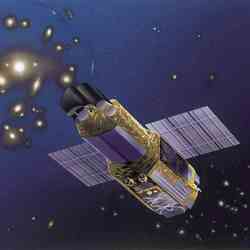
Artist illuatration of Astro-E2. Image credit: JAXA. Click to enlarge.
The M-V Launch Vehicle No. 6 (M-V-6) with the 23rd scientific satellite (ASTRO-EII) onboard was launched at 12:30 p.m. on July 10, 2005 (Japan Standard Time, JST) from the Uchinoura Space Center (USC). The launcher was set to a vertical angle of 80.2 degrees, and the flight azimuth was 87.6 degrees.
The launch vehicle flew smoothly, and the third stage motor was ignited at 205 seconds after liftoff. The third stage flight was also smooth, and after its motor burnout, it was confirmed to be safely injected into its scheduled orbit of an apogee altitude of approximately 247 km and a perigee altitude of approximately 560 km with an inclination of approximately 31.4 degrees.
JAXA received signals from the ASTRO-EII at the Santiago tracking station and the USC, and from those signals we verified that the ASTRO-EII had successfully separated.
The in-orbit ASTRO-EII was given the International Designator of 2005-025A and a nickname of “Suzaku.”
The weather at the time of the launch was slightly cloudy with a wind speed of 7m/s from the west-south-west, and the temperature was 31.7 degrees Celsius.
Original Source: JAXA News Release
